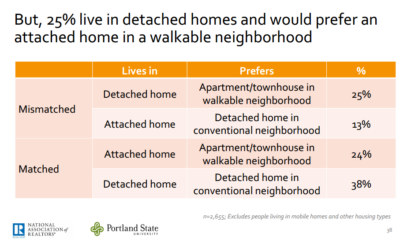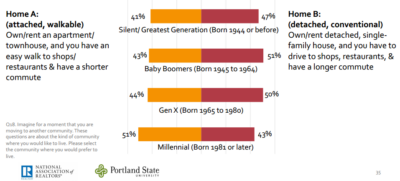When my wife and I bought our home, we were hoping to find something like a duplex or condo in walking distance to downtown Ypsilanti—to no avail. While there were dozens of single-family homes available at the time, only one duplex came up in 6 months of looking, and the condos available were all in complexes on major roads towards the edge of town. We ended up in a single-family home as the best-available choice, rather than because it was what we really wanted.
A new study by the National Association of Realtors and Portland State University suggests this is a common problem. Among other topics, their Community & Transportation Preferences Survey of 3,000 adults across the country’s metro areas looked at the homes (and places) people live in currently vs. the homes they’d like to live in.
A full 25% of respondents reported that they currently lived in detached, single-family homes, but would prefer to live in an apartment, townhouse, or condo in a more walkable neighborhood.

So why don’t they already live there? The NAR study doesn’t delve into that question, but it’s a safe bet that lack of available options plays a role. The survey shows that nearly half of respondents, across age groups, would prefer an “attached” home in a walkable neighborhood over a single family home that requires more driving. Yet across Michigan’s metro areas, only about 30% of housing units are attached of any kind, and a large share of those are in locations that could hardly be called “walkable”: massive complexes of bland beige-carpeted apartments sandwiched between strip malls on busy arterial roads are not what these respondents have in mind.
As further evidence of this supply/demand mismatch, where we do have quality multi-family home options in walkable downtowns and neighborhoods, Michigan is grappling with affordability problems: whether Midtown Detroit, downtown Grand Rapids, or downtown Royal Oak, housing options are scarce but highly sought-after, and prices are rising accordingly. Nearest to me, downtown Ann Arbor apartments are now leasing for as much as $2,000 per month, for a single bedroom: even the hundreds of new apartments being built every year can’t seem to make a dent in the pent-up demand for this living option.
While much coverage of the study focuses on millennials, the findings appear to hold up across generational cohorts:

Across generations, about as many Americans want attached homes in walkable locations as want detached homes in conventional developments.
Realtors obviously have a direct role in getting people into the homes they want, and when they say “more and more homebuyers are expressing interest in living in mixed-use, transit-accessible communities,” they’re in a strong position to know what homebuyers want, and how the market is failing them. Helping to correct this market failure and create more of the places that people wish they were living in is one of the most important outcomes that our placemaking work can have.